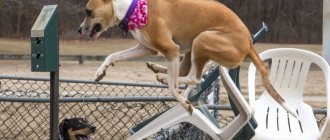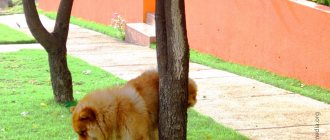Surely, many dog owners are familiar with the situation when a dog runs away during a walk and does not react in any way to the owner’s calls to come over. Very often I notice couples who generally walk on their own: the dog is alone, and the owner, somewhere on the sidelines, patiently waits for his pet to walk up and come to him, because calling and catching him is useless. For the same reason, many generally prefer not to let their four-legged pet off the leash. Yes, precautions will not hurt here.
But you don’t always have to lead your dog exclusively on a rope. Sometimes you want to remove restrictions and give your pet freedom, so that the pet can play to its heart’s content with its fellow animals and run after the ball. After all, this is very beneficial for the dog’s health.
So what are the reasons for such “escapes” of the dog? What to do if this happens, and how to wean your little one from this habit?
Reasons for running away on the street
While walking the dog, the owner establishes close contact with the pet, teaches useful skills and commands. At the same time, many owners are familiar with the situation when, during a walk, the dog runs home, runs in an unknown direction, absolutely not reacting to the name, commands, or indignant exclamations of the owner.
The main reasons for a dog to run away on the street:
- improper adaptation, socialization;
- errors in education;
- cruel, rude, or improper treatment of a pet;
- spoiled;
- passion, curiosity;
- fear, fright, emotional experience;
- freedom-loving, dominant character;
- predisposition to a free life;
- insufficient duration and activity of walks.
Important! As a rule, puppies up to 5-6 months old do not run away from their owners during walks as often as their adult relatives. According to statistics, the most “lost” dogs are dogs from 8-12 to 15 months. Hyperactive, overly inquisitive dogs, representatives of hunting breeds, and hounds are especially prone to escape.
Most often, hunting dog breeds run away due to their developed instinct. For example, a dog saw a cat or a bird and decided to run after the so-called prey, realizing his potential as a hunter.
Dogs with an easily excitable psyche can also run away from their owner. The dog may become excited when he sees a cyclist, a car, or becomes interested in other dogs or animals on the street. It is possible that the pet was alarmed or frightened by something, so the dog rushed home as fast as he could.
If the dog does not come after being called, perhaps when the dog came, you punished him. Dogs are good at remembering negative actions on the part of their owners, and if a pet runs away or refuses to approach you, it means that it is afraid that it will be punished.
Important! If the dog is guilty, after he approaches you, do not shout, do not hit, do not punish him. You undermine your authority by losing contact with the animal.
If the dog runs towards other dogs, it may be that he lacks communication with his relatives. This behavior can be caused by banal disobedience, ignorance of commands, or insufficient activity.
Dogs often run away during the rut. Instincts dictate, therefore, sensing a bitch in heat, the male will follow her and become uncontrollable. During the period of sexual hunting, not only the hormonal levels of animals change, but also their behavior.
Dogs, in most cases, do not like a leash. After all, it is this attribute that hinders freedom of action. Therefore, when you call your pet to you and plan to finish your walk, do not fasten the leash right away. The dog’s reflex is reinforced: once the owner called and fastened the leash, it means the walk is over and you need to return home. Don't forget that puppies and active young dogs can walk until they get tired or hungry.
Why might a dog run away from home? Dog handler answers
Announcements and posts on social networks about lost pets are, unfortunately, a common occurrence today. This problem is most often encountered by owners of hunting dogs, sled dogs and mongrels. And if this happens, it is important not only to discover the cause, but also to eliminate it. Roman Romanchik, junior inspector-dog handler of the service dog nursery of the Minsk City Administration of the Security Department of the Ministry of Internal Affairs, shared how to do this.
– In general, a dog is a predator. These are curious animals and are characterized by exploration of new territories. To prevent an animal from leaving without permission, you need to understand what pushes it to do so. The most common reasons for escapes, I would include improper training, fear, boredom and curiosity,
- the specialist introduces the matter.
Simple rules of behavior when walking with a dog
Walking with your beloved pet should be exciting, active, interesting and safe, both for your dog and for strangers, other dogs, and animals.
To properly organize a walk, consider simple rules of behavior when walking with a dog:
- You can walk your dog only in specially designated areas. Cities have equipped, fenced areas for walking animals. If there are none, you can walk your dog in forest plantations and remote areas of the park.
- You cannot walk your pet in public places, on beaches, playgrounds, gardens, and sanatoriums. In the city, the dog must be on a leash and muzzled. Small dog breeds and puppies up to 4-5 months do not need to wear a muzzle.
- Never let your dog off the leash near highways or roads, even if the pet perfectly follows commands. The dog may get carried away with something and not respond to your call.
- When walking, always monitor what your pet is doing. The dog can show interest in strangers, scare a child, or pick up a harmful “treat” from the ground.
- Be sure to teach your dog to follow basic commands (“come to me”, “near”, “fu” or “no”).
- For walks in the summer, take a bowl and drinking water. In winter, before going outside, to protect the paw pads from the chemicals that are sprinkled on the sidewalks, lubricate them with protective cream, wax, or buy shoes for your pet for winter walks.
- In hot weather, monitor your level of physical activity. This is especially true for brachycephalic dogs and long-haired breeds.
- Never call your dog to you in a threatening tone, even if the dog has done something wrong.
- Do not let your dog go in unfamiliar places.
- If a dog runs away, carried away by something, and does not respond to a nickname, the effect of surprise will help to return the fugitive. Throw keys at the animal, hang it, clap your hands.
The first walks with the puppy should take place in quiet, calm places, away from dogs, people, and other animals. Nothing should scare a small pet, otherwise, being frightened by something, the dog will subsequently run away from you home or in an unknown direction.
Until your little pet gets used to the street, walk him on a leash. Walking should take no more than 15-20 minutes. Gradually increase the time, paying special attention to proper socialization of the dog.
On walks, you are not the only one who must monitor the animal’s actions. The dog must be afraid of losing sight of you. Therefore, play hide and seek with the animal; if the dog is passionate about something, attract his attention, call him to you.
Take advantage of the Internet
How to find a lost dog? You have access to the Internet! This is the most effective way of informing. Literally from the first minutes of your search, publish a message on social networks that your dog is missing. Ask your friends to make this post go viral. Let it go through all possible distribution channels to reach as many people as possible.
Go to special dog groups on social networks and publish your message in them.
Ask people for help so that they can let you know if someone spots your dog on the street.
Involve not only social networks, but also the websites of your city. Especially specialized ones dedicated to the sale and search of animals.
Monitor online advertisements for dogs for sale when you suspect your pet has been stolen.
Information spreads fastest on the Internet. Therefore, the chances that your friends from Facebook, OK or VK will help you are much higher!
Teaching the dog the “Come to me” command
The dog, regardless of breed, must be trained and clearly follow basic commands, such as: “Near”, Fu”, “No”, “Place”, “Come”. Not all dogs make ideal students, especially those with inexperienced owners.
Advice! If you do not have animal training skills, you have your first dog, or your pet is very disobedient, seek help from a dog trainer. The specialist will find an approach to the dog and select the optimal training system.
We teach the dog the “Come to me” command:
- We conduct the first lessons on a long canvas leash. For large dogs, you can also use a strict collar during classes.
- As soon as the pet is a short distance from you, after a few seconds say the pet’s name and give the command in a strict, confident intonation.
- If the dog does not respond, pull the leash towards you.
- You can attract your dog's attention with a treat. As soon as the dog approaches, praise him and give him a treat. Always give your dog different treats. Alternate treats with rewards.
- In the future, replace the treat with praise so that the animal does not constantly associate the call with food.
- Once the dog begins to understand and follow the “come to me” command, begin training without a leash.
- Practice the command in different places and situations.
During your walk, repeat the command “Come to me” several times. Always praise your dog for doing the right thing. When the dog is walking without a leash and runs towards you, give the command “Come to me” several times during the walk.
Do not give a command when your pet is very passionate about something, especially in the first lessons. The dog must be focused on the training process. Attract the dog with a nickname, a treat, pull the leash, and when the dog looks in your direction or walks towards you, say a command in a clear intonation.
Important! The “Come to me” command should not be associated with punishment or something unpleasant for the pet. For example, do not call your dog if you are planning to cut its nails, clean its ears, or perform other hygienic or medical procedures that are not very pleasant for the pet.
Knowing the “Come to me” command, if the dog follows it unquestioningly, you don’t have to worry about the safety of your pet.
How to properly punish a dog for disobedience
Inappropriate behavior and disobedience can only be prevented by a properly organized training system. But it happens that the dog has mastered the commands perfectly, but refuses to carry them out, shows disobedience, demonstrates his freedom-loving character, behaved incorrectly on a walk, at home, the pet must be punished. To achieve the desired effect, you need to know how to properly punish a dog for disobedience:
- The maximum permissible actions are a slap with a newspaper, a click on the nose, a shake by the scruff of the neck.
- Never hit your dog with a leash. This accessory should evoke only positive emotions in your pet.
- The dog must be punished at the moment of committing an offense. Show your dissatisfaction. Scold your pet in a stern tone. Don't pay any attention to the dog. Dogs subtly pick up our emotions and mood. The biggest punishment for them is lack of attention from their beloved owner.
- Never scold your dog by calling him to you in a gentle tone. The dog will stop trusting you. If the dog does something wrong, switch its attention, use the effect of surprise (splash water, scream loudly, clap your hands).
Important! If the dog begins to be afraid of you and stops respecting you as a leader, do not be surprised if he runs away during a walk and becomes uncontrollable and disobedient. Remember that animal behavior is dictated by instincts. A dog will never do evil if it is treated with love, respect, and kindness.
Remember: you can do more
Today, running with a dog is reaching a professional level. There are canicross (not an ordinary jogging, but a sports discipline with its own championship) and special starts (the dog marathon in Peru, for example).
Cases when a pet and owner ran a half marathon together are also not uncommon. Try it too. Just remember that an athlete dog requires proper nutrition (use specially formulated sports food and energy supplements) and special care (regularly do an ECG, heart echogram and blood biochemistry, and also check joints).
In what cases will you need professional help?
Unfortunately, even with experience with dogs and knowing the basics of training, it is not always possible to raise a puppy into an obedient, fully controllable dog. Therefore, if you cannot cope with your pet, you have a dog of a fighting breed, a service breed, a canine specialist will help you instill the necessary behavioral skills.
In what cases will you need professional help:
- If you have no experience in dealing with animals.
- The dog is uncontrollable, reacts inadequately to stimuli, behaves poorly at home and on walks.
- If behavior correction is necessary in case of errors in upbringing.
- The dog shows aggression towards people and animals.
- The dog constantly runs away from his owner on the street and does not respond to commands.
- Against the backdrop of stress and severe emotional shock, the dog’s behavior has changed dramatically, and you don’t know what to do with your pet.
The help of an animal psychologist or dog handler may be needed if you adopted an adult dog from a shelter or took responsibility for the life of a homeless animal.
Freedom in the blood and a tendency to escape
In many ways, the character of a pet depends on genetics. Genetics, in turn, is determined by a person. We breed dogs for specific purposes. Some are ideal for hunting, others help save people. Certain traits are carefully maintained in the breed. Not all of them are convenient for owners. Some working animals enjoy freedom and rely less on a bond with their owner.
Which dogs should you take into your home with caution? There are always exceptions, but most often fugitives are found among pointers, hounds and sled breeds. Such pets must be trained from early childhood and their behavior must be constantly monitored. This is hard and painstaking work. Any mistake can lead to dire consequences, so it is better to think in advance about whether you can cope with an overly active dog.
How to catch a runaway dog
If your pet runs away while out for a walk, you shouldn’t hope that the dog will return home on its own. Although this is also possible. But being in an unfamiliar area, the dog loses its bearings and runs wherever its eyes look. How to catch a runaway dog?
If the dog suddenly runs, call him, say his name loudly, and give the command “Come to me” in a stern tone. Use the effect of surprise. In some cases, this helps distract the dog's attention from further negative actions.
Follow the dog's route, trying not to lose sight of it. Analyze what your dog might do and what caused the escape.
Did you manage to catch the fugitive and silently grab him by the withers? In this case, scold the dog, use all methods of influence so that the dog understands that doing this is not good. If the dog, with its head down, came up to you after running away, in this case all that remains is to praise it.
Stop action
Ideally, your dog will run towards you. But this requires him to stop and change route, which can be difficult. For a simpler approach, encourage him to stop and lie down.
One of the best skills to learn is to lie down quickly. It is easier for a dog to fall than to turn around and run towards a person.
Therefore, teach your dog the “LIE” command in advance.
In fact, you can sit down and then pretend that you are playing with a toy to entice your dog to come take a look.
How to find a dog if it's completely lost
If the dog runs away and is out of sight for 5-10 minutes, for the owner this time seems like an eternity. What to do and how to find a dog if it has completely run away?
Helpful Tips:
- Let go of panic and emotions. Act consistently, but don't waste a minute. The search result depends on the speed of your reaction;
- If the dog does not return to you within a few minutes, think about what caused this behavior.
- Walk around the area several times, visit all the places where you most often walk with your pet.
- Ask passers-by and dog lovers you know, maybe they saw the fugitive. It is possible that the dog was scared and ran home.
- If the search was unsuccessful and the dog did not return home, print out an advertisement with a detailed description of the pet and a photograph. Be sure to include a guaranteed reward for the return of the dog.
- Call your city dog control office. Provide employees with all necessary information.
- If your pet is microchipped, contact the city’s veterinary clinics and notify the Club the dog belongs to.











